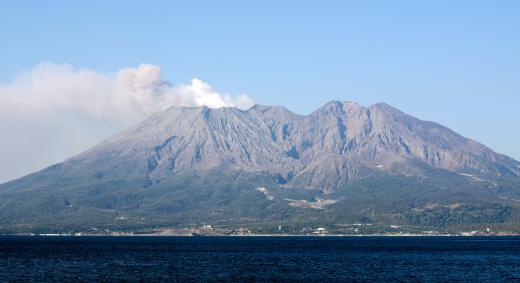What is a Fumarole?
 Mary McMahon
Mary McMahon
A fumarole is a hole in the Earth's crust which vents gases. Fumaroles are usually found around areas of volcanic activity, although they can appear anywhere. If enough groundwater is present, the vent may turn into a hot spring, creating a supply of bubbling naturally hot water which is heated by the escaping gases. Historically, hot springs have been believed to be beneficial for human health, with communities arising around springs to promote “taking the waters” of the springs.
Sometimes fumaroles develop during periods of increased geologic activity, and at other times, they may be active while a nearby volcano itself is dormant. Fumaroles can appear alone or in fields, and they may change position periodically as well. The escaping gases can be quite hot and sometimes dangerous, making it necessary for researchers who work around fumaroles to wear proper protection.

In some cases, the vent may exist for centuries, with varying levels of activity. In other instances, a fumarole may only last for a few days, as seen when a vent forms in a fresh lava field and the lava hardens, sealing the vent off. The composition of fumarole gases can vary, depending on the location, and some are surrounded with crystals of solidified vented material such as sulfur; these crystals can be a telltale sign that a fumarole once existed, even if an area is no longer geologically active.

If the gases in a fumarole are rich in sulfur, it may be known as a solfatara, after the Italian word for sulfur. Carbon dioxide-rich fumaroles are known as mofettes. Fumarolic activity can sometimes be a warning sign of geologic activity, making these openings in the Earth's crust a topic of interest for researchers and people who are attempting to create geological forecasts. If activity increases or the composition of gases changes, it may indicate that disruption is happening inside the Earth's crust and that a volcanic eruption or earthquake may occur.
Fumaroles are often surrounded by a cloud of steam. This occurs when heated gases from the fumarole vaporize groundwater in the area, causing steam to form. Sometimes the steam is varicolored as a result of impurities in the gases, while at other times it may be plain white. People should be careful around the steam because it is extremely hot and it can cause burns. It is also advisable to be careful about walking around or on a fumarole field because there may be weak points in the Earth's crust or unexpected eruptions which could pose a safety threat.
AS FEATURED ON:
AS FEATURED ON:












Discuss this Article
Post your comments